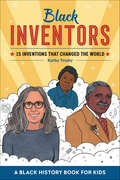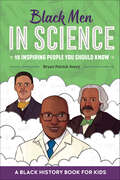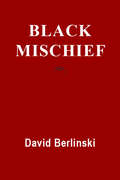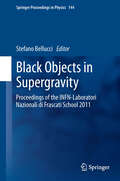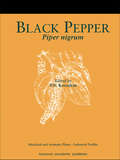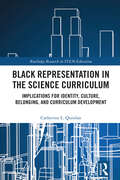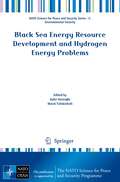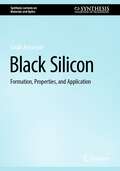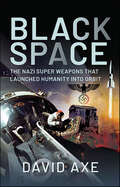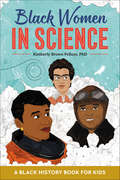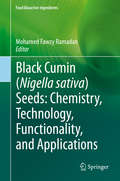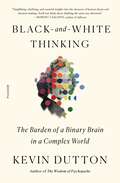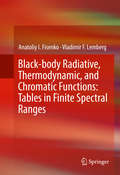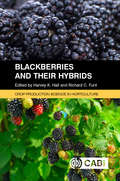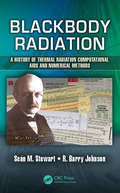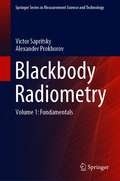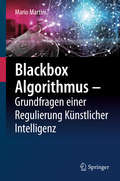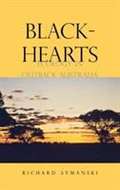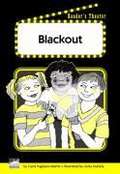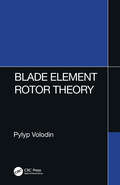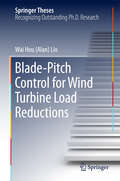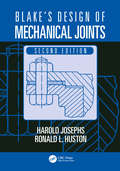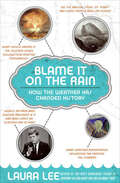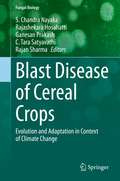- Table View
- List View
Black Inventors: 15 Inventions that Changed the World (Biographies for Kids)
by Kathy TrustyDiscover 15 inventors and inventions that changed the world in this guide for kids ages 8 to 12Throughout history, Black inventors have achieved some of the world's greatest advancements in science, technology, engineering, and math. This book highlights 15 men and women who made a big impact with their inventions—from Marie Van Brittan Brown, who created the first home security system, to Mark Dean, who invented the personal computer. Learn all about each inventor's creative process, their invention, and the way it's benefited our world.The "first Black man of science"—Explore how Benjamin Banneker used his knowledge of math and science to build the first wooden clock, create an almanac, and help design the city that became Washington, D.C.An innovator in Black hair care—Learn how Lyda Newman became an inventor at the early age of 14, when she engineered an improved hairbrush design that made it easier and more affordable to properly care for Black hair.A web technology expert—Find out how Lisa Gelobter developed internet technology inventions that people rely on every day, including web animation, GIFs, and online videos.Take a journey through the stories of Black inventors and their inventions, with this guide designed just for kids.
Black Men in Science: 15 Inspiring People You Should Know (Biographies for Kids)
by Bryan Patrick AveryIncredible stories of Black men who changed the course of science—for kids ages 8 to 12 All throughout history, Black men have made important contributions to scientific discovery. This collection of biographies for kids explores 15 of these intelligent men and the extraordinary scientific accomplishments they achieved—even when they faced huge challenges. You'll learn how they stood up against racism and inequality, and never stopped following their passions for science, technology, engineering, and mathematics.Meet talented Black men in history who have helped:Explore our world—Discover inventors like Lewis Howard Latimer and biologists like George Washington Carver, and find out how they expanded our understanding of the world around us.Advance medicine—Learn the stories of doctors like James McCune Smith and Leonidas Berry who helped stop the spread of disease and change the way we perform surgery.Change the game—Find out how people like geneticist Rick Kittles and engineer Roy L. Clay Sr. are still doing important research and breaking barriers.Dive into a world of inspiring men with this scientific entry into Black history books for kids.
Black Mischief
by David BerlinskiFrom the Preface to the Second Edition:"This book will not take the casual reader to the cutting edge of research. Nor is it meant to. What I am after in Black Mischief is the moment in which various lines in an intellectual field of force collect themselves into a kind of dense knot...A number of otherwise sympathetic reviewers have suggested that my aim in Black Mischief was somehow to show the persistence of certain outmoded Newtonian forms of thought in economics, or psychology, or biology, or wherever. Not so. My intention has been to explore a tangle of connected concepts."Black Mischief is the cogent and absorbing story of an unusually fertile period in the contemporary science. Irreverent, witty, skeptical, and always informative, it is an anecdotal potpourri of scientific thought and the people who shaped it. Berlinski takes a protean look at the science establishment - as well as the personalities behind the scenes - in such fields as behavioral psychology, linguistics, and economics, and in so doing enlightens and entertains us beyond measure.
Black Objects in Supergravity: Proceedings of the INFN-Laboratori Nazionali di Frascati School 2011 (Springer Proceedings in Physics #144)
by Stefano BellucciThis is the sixth volume in a series of books on the general topics of supersymmetry, supergravity, black holes and the attractor mechanism. The present volume is based upon lectures held in May 2011 at the INFN-Laboratori Nazionali di Frascati School on Black Objects in Supergravity (BOSS2011), directed by Stefano Bellucci, with the participation of prestigious lecturers, including G. Lopes Cardoso, W. Chemissany, T. Ortin, J. Perz, O. Vaughan, D. Turton, L. Lusanna and S. Ferrara. All lectures were at a pedagogical, introductory level, a feature which is reflected in the specific "flavor" of this volume, which also benefited greatly from extensive discussions and related reworking of the various contributions.
Black Pepper: Piper nigrum (ISSN #Vol. 13)
by P. N. RavindranBlack Pepper is the first monograph on this important and most widely used spice. This volume includes chapters on all aspects of the crops' botany; crop improvement, agronomy, chemistry, post-harvest technology, processing, diseases, insect pests, marketing, economy and uses. All the available information has been collected and presented by expert
Black Representation in the Science Curriculum: Implications for Identity, Culture, Belonging, and Curriculum Development (Routledge Research in STEM Education)
by Catherine L. QuinlanThis book sheds new light on the importance of Black representation in the US science curriculum from a social, cultural, cognitive, and scientific perspective.Weaving together content, new methodologies, and science education pedagogies, it opens up new space for the meaningful inclusion of the science capital and cultural capital of Black people in the US science curricula. Drawing on ethnographic interviews with African American Gullah-Geechee and research outcomes from qualitative and quantitative research and curriculum development, it brings home the importance of attending to a sense of belonging in the K-12 science curricula toward lasting equity and inclusion. The author uses applied cognitive psychology theories as frameworks to show how perceptions about the perceived value of Black representation as a way of knowing is influenced by identity, culture, and social schemas.Incorporating new methodologies and approaches focused on inclusion and belonging, it will appeal to scholars, researchers, upper-level and post-graduate students with interest in STEM education, race and ethnicity in education, equity, and research methods in education.
Black Sea Energy Resource Development and Hydrogen Energy Problems (NATO Science for Peace and Security Series C: Environmental Security)
by Ayfer Veziroğlu Marat TsitskishviliNATO Advanced Research Workshop "The Black Sea: Strategy for Addressing its Energy Resource Development and Hydrogen Energy Problems" was held in order to evaluate the Black Sea Region's environment, discuss the ways and means of protecting it, and to evaluate the methods of production of the energy carrier, hydrogen. Papers presented at the workshop, proposed various methods of hydrogen production from the hydrogen sulfide, from marine macro algae and other bacteria, storage and utilization of hydrogen, oil spills and pollutants in the Black Sea, degradation of the sea and the land around the region, and ways and means of protecting the environment. The workshop participants unanimously expressed the need to establish close cooperation amongst the Region's countries regarding the development of its energy resources, and at the same time protecting its environment. These recommendations have been put together in the Batumi Manifesto. This book entitled "Black Sea Energy Resource Development and Hydrogen Energy Problems" puts together the papers presented at the workshop, starting with the Batumi Manifesto. This valuable volume should be in the libraries of all the scientists, engineers, environmentalists, economists and decision makers involved in the development of the Black Sea Region and in the introduction of clean and abundant Hydrogen Energy.
Black Silicon: Formation, Properties, and Application (Synthesis Lectures on Materials and Optics)
by Gagik AyvazyanThe book systematically accounts for the scientific and technological problems of nanostructured silicon in the form of porous and black silicon. Nanostructured silicon is currently a pioneer research topic worldwide due to its enormous potential applications for modern electronic devices, such as sensitive photodetectors, solar cells, biochemical sensors, hydrogen generators, and display devices. The main structural modifications of this nanomaterial are porous and black silicon. Porous silicon addresses crystalline silicon with nanopores and black silicon with nanoneedles. Historically, porous silicon is thought to be a kind of precursor to black silicon. The formation, research, and application of nanostructured silicon remains the main cornerstone of nanotechnologies, and this book is useful for a wide range of researchers in the fields of semiconductor physics, micro-, and nanoelectronics. The author outlines the prospect of black silicon fabrication and its various applications. As for porous silicon, the book contains a detailed analysis of this material as a precursor of black silicon. This allows it to be possible to carry out correlations between two structural modifications of nanostructured silicon to clearly and reasonably show their advantages and disadvantages. With many references to a vast resource of recently published literature, this book serves as an important and insightful source of valuable information and provides scientists and engineers with new ideas to better understand the formation processes of nanostructured silicon as well as improve and expand their properties.
Black Space: The Nazi Superweapons That Launched Humanity Into Orbit
by David AxeOrbital fortresses poised to fry entire cities with no warning using giant mirrors. Bombers that take off from Earth, punch through the thin border between the atmosphere and vacuum and take advantage of that lofty altitude to speed across the globe on missions of mass destruction. These and other exotic orbital weapons were under consideration, or even active development, in the early decades of humanity’s push into space. And no wonder. The era of frantic, dueling, American and Soviet space-exploration efforts -- which stretched from the end of World War II to the United States’ successful Moon landing in July 1969 -- had its roots in Nazi Germany, a country that pinned its hope for global conquest on equally ambitious superweapons. In the decades following World War II, the top scientists in the U.S. and Soviet space programs were ex-Nazis—most notably rocket-designer Wernher von Braun, who sided with the Americans. The basic technologies of the space race derived from Nazi superweapons, in particular von Braun’s V-2 rocket. But orbital war never broke out in those heady decades of intense space competition. It’s possible to triangulate the moment the seemingly inevitable became evitable. July 29, 1958. The day U.S. president Dwight Eisenhower reluctantly signed the law creating the National Aeronautics and Space Administration. Starting that day, the U.S. military gradually ceded to NASA, a civilian agency, leadership of American efforts in space. Even von Braun, once a leading advocate of orbital warfare, went along. Space-based superweapons and their architects, and the high-stakes politics that reined them in, are the subject of this brief book.
Black Women in Science: A Black History Book for Kids (Biographies for Kids)
by Kimberly Brown PellumLearn about amazing Black women in STEM—15 fascinating science biographies for kids 9 to 12Throughout history, Black women have blazed trails across the fields of science, technology, engineering, and mathematics. Black Women in Science brings something special to black history books for kids, celebrating incredible Black women in STEM who have used their brains, bravery, and ambition to beat the odds.Discover 15 science stories for kids that explore the lives of bold female scientists. Learn how each of them advanced their STEM fields and fought to build a legacy. Through the triumphs of these amazing women, you'll find remarkable role models.Above and beyond—Soar into the sky and outer space with Mae Jemison, Annie Easley, and Bessie Coleman.Part of the solution—Discover the power of mathematics with Katherine Johnson and Gladys West.The doctor is in—Explore a life of healing with Mamie Phipps Clark, Jane Cooke Wright, and many more.Find the inspiration to blaze your own trail with this incredible children's book about Black history!
Black cumin (Food Bioactive Ingredients)
by Mohamed Fawzy RamadanRecent developments in the field of nutrition have led to increased interest in herbs and medicinal plants as phytochemical-rich sources for functional food, nutraceuticals, and drugs. As research sheds light on the therapeutic potential of various bioactive phytochemicals, the demand for plant extracts and oils has increased. Black cumin or black seeds (Nigella sativa) have particularly widespread nutritional and medicinal applications. In traditional medicine, black seeds are used to manage fatigue and chronic headache. Black seed oil is used as an antiseptic and analgesic remedy and for treatment of joint's pain and stiffness and can be mixed with sesame oil to treat dermatosis, abdominal disorders, cough, headache, fever, liver ailments, jaundice, sore eyes, and hemorrhoids. Thymoquinone, the main constituent in black seed volatile oil, has been shown to suppress carcinogenesis. Black cumin (Nigella sativa) seeds: Chemistry, Technology, Functionality, and Applications presents in detail the chemical composition, therapeutic properties, and functionality of high-value oils, phytochemicals, nutrients, and volatiles of the Nigella sativa seed. Organized by formulation (seeds, fixed oil, essential oil, and extracts), chapters break this seed down into its chemical constituents and explore their role in the development of pharmaceuticals, nutraceuticals, novel food, natural drugs, and feed. Following numerous reports on the health-promoting activities of Nigella sativa, this is the first comprehensive presentation of the functional, nutritional, and pharmacological traits of Nigella sativa seeds and seed oil constituents.
Black-and-White Thinking: The Burden of a Binary Brain in a Complex World
by Kevin DuttonA groundbreaking and timely book about how evolutionary biology can explain our black-and-white brains, and a lesson in how we can escape the pitfalls of binary thinking.Several million years ago, natural selection equipped us with binary, black-and-white brains. Though the world was arguably simpler back then, it was in many ways much more dangerous. Not coincidentally, the binary brain was highly adept at detecting risk: the ability to analyze threats and respond to changes in the sensory environment—a drop in temperature, the crack of a branch—was essential to our survival as a species. Since then, the world has evolved—but we, for the most part, haven’t. Confronted with a panoply of shades of gray, our brains have a tendency to “force quit:” to sort the things we see, hear, and experience into manageable but simplistic categories. We stereotype, pigeon-hole, and, above all, draw lines where in reality there are none. In our modern, interconnected world, it might seem like we are ill-equipped to deal with the challenges we face—that living with a binary brain is like trying to navigate a teeming city center with a map that shows only highways. In Black-and-White Thinking, the renowned psychologist Kevin Dutton pulls back the curtains of the mind to reveal a new way of thinking about a problem as old as humanity itself. While our instinct for categorization often leads us astray, encouraging polarization, rigid thinking, and sometimes outright denialism, it is an essential component of the mental machinery we use to make sense of the world. Simply put, unless we perceived our environment as a chessboard, our brains wouldn’t be able to play the game. Using the latest advances in psychology, neuroscience, and evolutionary biology, Dutton shows how we can optimize our tendency to categorize and fine-tune our minds to avoid the pitfalls of too little, and too much, complexity. He reveals the enduring importance of three “super categories”—fight or flight, us versus them, and right or wrong—and argues that they remain essential to not only convincing others to change their minds but to changing the world for the better. Black-and-White Thinking is a scientifically informed wake-up call for an era of increasing extremism and a thought-provoking, uplifting guide to training our gray matter to see that gray really does matter.
Black-body Radiative, Thermodynamic, and Chromatic Functions: Tables In Finite Spectral Ranges
by Anatoliy I. I. Fisenko Vladimir F. F. LembergThis book provides detailed calculated values for the thermal radiative and thermodynamic functions of black-body radiation in finite spectral ranges. The results are presented in tabular form. The areas of thermal power generation, infrared medical diagnostics, solar power and nuclear generation, and astrophysics are included. A range of the thermal radiative and thermodynamic functions are calculated by the authors in the finite frequency/wavenumber/wavelength intervals at different temperatures. This book also contains the tables of the chromaticity coordinates and RGB parameters calculated for different color spaces (Rec. 709 (HDTV), sRGB, Adobe RGB). A number of the optimization problems is formulated and solved for various thermal black-body radiative and thermodynamic functions in a finite range of frequencies.
Blackberries and Their Hybrids (Crop Production Science in Horticulture)
by Eric Hanson Ellen Thompson Penelope Perkins-Veasie Kim Hummer Gail Nonnecke Bernadine Strik Marvin Pritts Dr John Clark Professor Michael Duffy Dr Chad Finn Dr Yu Igao Gao Dr Jungmin Lee Dr Robert R Martin Dr Sukalya Poothong Dr Barbara Reed Dr David Ross Dr Annemiek C Schilder Michele Stanton Dr Fumiomi Takeda Dr Ioannis TzanetakisThis practical book provides a comprehensive and accessible overview of all aspects of the commercial production of blackberries and their hybrids, covering plant growth and development, cultivar description and selection, propagation, pruning, soil and water management, postharvest management, economics and marketing, and pest identification and management. Cultivated blackberries are a relatively new crop, but with new cultivars and cultural practices they are now grown and available worldwide. Production regions have expanded internationally due to innovative methods showing much promise and evidence of human health benefits. Blackberries and Their Hybrids explains the many complex steps involved in producing a conventional or an organic crop for the fresh and processed markets, and: - Contains information gathered from global sources - Is appropriate for areas that can produce blackberries for the local, domestic and/or export markets - Includes full-color images throughout Authored by a team of experts, this book is essential for growers, extension workers, fruit industry personnel, students, and lecturers involved in the commercial production of blackberries and their hybrids.
Blackbody Radiation: A History of Thermal Radiation Computational Aids and Numerical Methods (Optical Sciences and Applications of Light)
by Sean M. Stewart R. Barry JohnsonShelving Guide: Electrical Engineering In 1900 the great German theoretical physicist Max Planck formulated a correct mathematical description of blackbody radiation. Today, understanding the behavior of a blackbody is of importance to many fields including thermal and infrared systems engineering, pyrometry, astronomy, meteorology, and illumination. This book gives an account of the development of Planck’s equation together with many of the other functions closely related to it. Particular attention is paid to the computational aspects employed in the evaluation of these functions together with the various aids developed to facilitate such calculations. The book is divided into three sections. Section I – Thermal radiation and the blackbody problem are introduced and discussed. Early developments made by experimentalists and theoreticians are examined as they strove to understand the problem of the blackbody. Section II – The development of Planck’s equation is explained as are the all-important fractional functions of the first and second kinds which result when Planck’s equation is integrated between finite limits. A number of theoretical developments are discussed that stem directly from Planck’s law, as are the various computational matters that arise when numerical evaluation is required. Basic elements of radiometry that tie together and use many of the theoretical and computational ideas developed is also presented. Section III – A comprehensive account of the various computational aids such as tables, nomograms, graphs, and radiation slide rules devised and used by generations of scientists and engineers when working with blackbody radiation are presented as are more recent aids utilizing computers and digital devices for real-time computations. Scientists and engineers working in fields utilizing blackbody sources will find this book to be a valuable guide in understanding many of the computational aspects and nuances associated with Planck’s equation and its other closely related functions. With over 700 references, it provides an excellent research resource.
Blackbody Radiometry: Volume 1: Fundamentals (Springer Series in Measurement Science and Technology)
by Alexander Prokhorov Victor SapritskyThis book, the first of a two-volume set, focuses on the basic physical principles of blackbody radiometry and describes artificial sources of blackbody radiation, widely used as sources of optical radiation, whose energy characteristics can be calculated on the base of fundamental physical laws.Following a review of radiometric quantities, radiation laws, and radiative heat transfer, it introduces the basic principles of blackbody radiators design, details of their practical implementation, and methods of measuring their defining characteristics, as well as metrological aspects of blackbody-based measurements. Chapters are dedicated to the effective emissivity concept, methods of increasing effective emissivities, their measurement and modeling using the Monte Carlo method, techniques of blackbody radiators heating, cooling, isothermalization, and measuring their temperature.An extensive and comprehensive reference source, this book is of considerable value to students, researchers, and engineers involved in any aspect of blackbody radiometry.
Blackbox Algorithmus – Grundfragen einer Regulierung Künstlicher Intelligenz
by Mario MartiniDieses Buch liefert eine rechtswissenschaftliche Analyse der Chancen und Gefahren algorithmenbasierter Verfahren. Algorithmen, die im Maschinenraum moderner Softwareanwendungen werkeln, sind zu zentralen Steuerungsinstanzen der digitalen Gesellschaft avanciert. Immer nachhaltiger beeinflussen sie unser Leben. Ihre Funktionsweise gleicht aber teilweise einer Blackbox. Die in ihr schlummernden Risiken zu bändigen, fordert die Rechtsordnung heraus. Das Buch beleuchtet die gesellschaftlichen Gefahren einer zunehmenden gesellschaftlichen Steuerung durch Algorithmen und entwickelt erste Regulierungsideen, mit deren Hilfe sich die Wertschöpfungspotenziale automatisierter digitaler Prozesse mit den Grundwerten der Rechtsordnung versöhnen lassen.
Blackhearts: Ecology in Outback Australia
by Richard SymanskiThis fascinating book is a firsthand account of the adventures of an ornithological field team studying long-tailed finches in outback Australia. In 1991, Nancy Burley, a noted behavioral ecologist, and her husband, Richard Symanski, went to Australia with their one-year-old son and four American students hired as field assistants and babysitter. The social relationships and problems that developed among these individuals in confined and exotic settings and the scientific discoveries that did -- and did not -- take place form the heart of the book. Symanski begins by telling how he and his wife set up this elaborate field expedition -- including the hiring of what seemed to be qualified, compatible, and knowledgeable field assistants. He then describes the harsh realities of their circumstances in Australia: primitive living conditions on an outback cattle station; field sites and subjects for study that were not as expected; and students who were not prepared for the rigors of field life and who became unenthusiastic about the work for which they had been hired. And he tells how he and his wife strove to overcome all the different challenges with which they were confronted. The book provides insight into the demands of professor-student-based fieldwork, particularly when generational conflicts, differing expectations, and culture shock complicate the "business" of doing science.
Blackout
by Carol Pugliano-Martin Anne Flounders Anita DufallaPerform this script based on the blackout of 2003 and how the blackout forced kids to play outside and meet new friends.
Blade Element Rotor Theory
by Pylyp VolodinBlade Element Rotor Theory This book presents an extension of the conventional blade element rotor theory to describe the dynamic properties of helicopter rotors. The presented theory focuses on the accurate mathematical determination of the forces and moments by which a rotor affects its rotorcraft at specified flight conditions and control positions. Analyzing the impact of a blade's non-uniform properties, the book covers blade twisting, the non-rectangular planform shape of a blade, and inhomogeneous airfoil along the blade. It discusses inhomogeneous induced airflow around a rotor disc in terms of the blade element rotor theory. This book also considers the impact of flapping hinge offset on the rotor's dynamic properties. Features • Focuses on a comprehensive description and accurate determination of the rotor's aerodynamic properties • Presents precise helicopter rotor properties with inhomogeneous aerodynamic properties of rotor blades • Considers inhomogeneous distribution of induced flow • Discusses a mathematical model of a main helicopter rotor for a helicopter flight simulator This book is intended for graduate students and researchers studying rotor dynamics and helicopter flight dynamics
Blade-Pitch Control for Wind Turbine Load Reductions
by Wai Hou LioThis thesis investigates the use of blade-pitch control and real-time wind measurements to reduce the structural loads on the rotors and blades of wind turbines. The first part of the thesis studies the main similarities between the various classes of current blade-pitch control strategies, which have to date remained overlooked by mainstream literature. It also investigates the feasibility of an estimator design that extracts the turbine tower motion signal from the blade load measurements. In turn, the second part of the thesis proposes a novel model predictive control layer in the control architecture that enables an existing controller to incorporate the upcoming wind information and constraint-handling features. This thesis provides essential clarifications of and systematic design guidelines for these topics, which can benefit the design of wind turbines and, it is hoped, inspire the development of more innovative mechanical load-reduction solutions in the field of wind energy.
Blake's Design of Mechanical Joints (Mechanical Engineering)
by Ronald L. Huston Harold JosephsBlake's Design of Mechanical Joints, Second Edition, is an updated revision of Alexander Blake’s authoritative book on mechanical joint and fastener design. This revision brings Blake’s 1985 volume up-to-date with modern developments in joint design, and recent technological advances in metallic and non-metallic materials, and in adhesive joining technologies. The book retains Blake’s lucid, readable style and his balance of basic concepts with practical applications. Coverage of statistical methods, computational software usage, extensive examples, and a full glossary have been added to make the new edition a comprehensive, practical sourcebook for today's mechanical design engineers.
Blame It on the Rain: How the Weather Has Changed History
by Laura LeeAn amazing, enlightening, and endlessly entertaining look at how weather has shaped our world.Throughout history, great leaders have fallen, the outcomes of mighty battles have been determined, and the tides of earth-shattering events have been turned by a powerful, inscrutable force of nature: the weather. In Blame It on the Rain, author Laura Lee explores the amazing and sometimes bizarre ways in which weather has influenced our history and helped to bring about sweeping cultural change. She also delights us with a plethora of fascinating weather-related facts (Did you know that more Britons die of sunburn every year than Australians?), while offering readers a hilarious overview of humankind's many absurd attempts to control the elements.If a weather-produced blight hadn't severely damaged French vineyards, there might never have been a California wine industry. . . .What weather phenomenon was responsible for the sound of the Stradivarius?If there had been a late autumn in Russia, Hitler could have won World War II. . . .Did weather play a part in Truman's victory over Dewey?Eye-opening, edifying, and totally unexpected, Blame It on the Rain is a fascinating appreciation of the destiny-altering vagaries of mother nature—and it's even more fun than watching the Weather Channel!
Blast Disease of Cereal Crops: Evolution and Adaptation in Context of Climate Change (Fungal Biology)
by Rajan Sharma S. Chandra Nayaka H. Rajashekara Ganesan Prakash C. Tara SatyavathiBlast is an important foliar disease that infects the majority of cereal crops like rice, finger millet, pearl millet, foxtail millet and wheat, and thus resulting in a huge economic impact. The pathogen is responsible for causing epidemics in many crops and commonly shifts to new hosts. Magnaporthe spp. is the most prominent cause of blast disease on a broad host range of grasses including rice as well as other species of poaceae family. To date, 137 members of Poaceae hosting this fungus have been described in Fungal Databases. This book provides information on all blast diseases of different cereal crops. The pathogen evolves quickly due to its high variability, and thus can quickly adapt to new cultivars and cause an epidemic in a given crop. Some of the topics covered here include historical perspectives, pathogen evolution, host range shift, cross-infectivity, and pathogen isolation, use of chemicals fungicides, genetics and genomics, and management of blast disease in different cereal crops with adoption of suitable methodologies.In the past two decades there have been significant developments in genomics and proteomics approaches and there has been substantial and rapid progress in the cloning and mapping of R genes for blast resistance, as well as in comparative genomics analysis for resolving delineation of Magnaporthe species that infect both cereals and grass species. Blast disease resistance follows a typical gene-for-gene hypothesis. Identification of new Avr genes and effector molecules from Magnaporthe spp. can be useful to understand the molecular mechanisms involved in the fast evolution of different strains of this fungal genus. Advances in these areas may help to reduce the occurrence of blast disease by the identification of potential R genes for effective deployment. Additionally, this book highlights the importance of blast disease that infects different cereal hosts in the context of climate change, and genomics approaches that may potentially help in understanding and applying new concepts and technologies that can make real impact in sustainable management of blast disease in different cereal crops.
